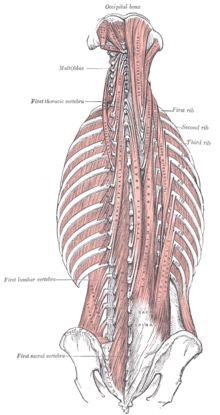Erector spinae muscle
The erector spinae muscle ( Latin for "erector of the spine"), also back extensor or back extensor muscle, refers to a larger group of muscles that serve to straighten or stretch as well as rotate and bend the spine ( intertransversarius muscle ) .
The term erector spinae muscle is usually not assigned a sharply defined term, which is why it is reluctantly used by anatomists. Sometimes it is used to describe the entire autochthonous back muscles , sometimes only sections of them, namely the iliocostalis , longissimus and spinalis muscles . Often these three are collectively called "the back extensor" or - in the plural - "the back extensor".
The back extensors run along the spine. They do not stand out clearly on the body surface, but you can feel them as a bulge on the side of the spine. Physiotherapeutic exercises to strengthen muscles, especially the back extensor, are used in the treatment of Scheuermann's disease ("hunched back").
In slaughter cattle, parts of the erector spinae muscle form the portions of rib , prime rib and roast beef , and in slaughter pigs the chop . With sheep and veal, the cutlet is also called square .
See also
Individual evidence
- ^ Richard L. Drake, Wayne Vogl, Adam WM Mitchell: Gray's Anatomy for Students . Elsevier, Urban & Fischer, 2007, ISBN 978-3-437-41231-8 , pp. 59 .
- ↑ Franz-Viktor Salomon: muscle tissue . In: Anatomy for veterinary medicine . 3. Edition. Enke, Stuttgart 2015, ISBN 978-3-8304-1288-5 , pp. 182-183 .
